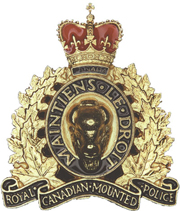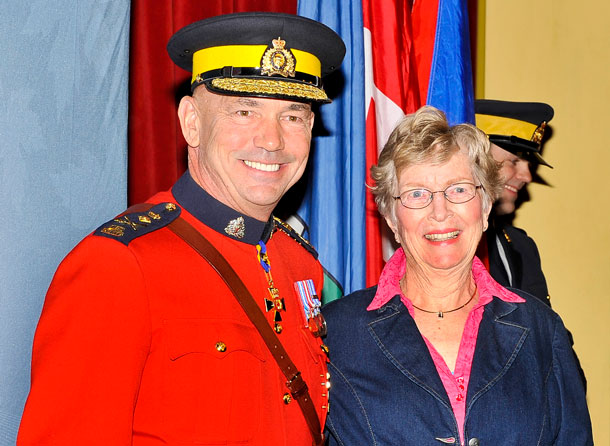 CALGARY – Crimebeat – The RCMP has a special place in Canada’s history. The history of Western Canada and the Royal Canadian Mounted Police are tied together tightly. Today at a ceremony at Fort Calgary’s Burnswest Theatre, the RCMP officially recognized 27 women now living in Southern Alberta who supported their husbands’ careers in isolated and one-man RCMP postings from the 1940s through the early 1980s.
CALGARY – Crimebeat – The RCMP has a special place in Canada’s history. The history of Western Canada and the Royal Canadian Mounted Police are tied together tightly. Today at a ceremony at Fort Calgary’s Burnswest Theatre, the RCMP officially recognized 27 women now living in Southern Alberta who supported their husbands’ careers in isolated and one-man RCMP postings from the 1940s through the early 1980s.
RCMP Honour Wives of Early Officers
More than 100 friends and family were on hand as RCMP Commissioner Bob Paulson presented “Second Man” commemorative brooches to recipients.
“Stories of the frontier Mountie are legend, but one of the least known facts is that often the second man helping them out was a woman,” said RCMP Commissioner Bob Paulson. “These women’s stories are important to the RCMP and to the fabric of Canada. Recognizing their contributions gives us all a stronger understanding of our history.”
Centenarian Madge Grayson was recognized for working alongside her husband at the one-man Fort Vermilion RCMP detachment in northern Alberta from 1936-39.
“These women would answer the door, make meals for the prisoners, wash the floors, deal with citizen complaints – they did a lot of work and were never recognized and never paid,” said Bob Kells, President of the RCMP Veterans’ Association Calgary. “Their assistance was vital to the whole operation.”

In 2004, author Ruth Lee-Knight published the book, When the Second Man Was a Woman, a compilation of 21 stories about RCMP detachment wives who had supported their husband’s careers in isolated and one-man postings in Saskatchewan from the 1940’s through the 1970’s. A detachment wife like her mother, Lee Knight worked alongside her Mountie husband Jack throughout his career.
In 2010 after reading the book, Calgarian Ivy-Anne Mitchell was inspired to write to Commissioner William Elliott asking the RCMP to officially recognize the 21 women in the book and others like them for their invaluable contributions to the Force over the years.
The Commissioner directed the RCMP Honours and Recognition Directorate, in consultation with the RCMP Veterans’ Association, to develop an appropriate mechanism for acknowledging these women. A “Second Man” commemorative brooch was created in recognition of their steadfast and loyal support of the RCMP and its members.
A call went out through local RCMP Veterans’ Canada-wide to locate women who had served the RCMP in this manner. To date, more than 470 women have been identified to receive the brooches. In the coming months, these women will be recognized by the Commanding Officers in the provinces where they now reside. The Fort Calgary event was the inaugural “Second Man” ceremony and recognized recipients who now reside in Southern Alberta.
As “Second Men” these RCMP wives performed a range of duties in support of police operations including cooking and caring for prisoners, filing, transporting and searching female prisoners, taking complaints, compiling accident reports, and comforting crime victims and families after accidental deaths. They were often left alone overnight or for extended periods of time when their husbands were on patrol. Some provided nursing services in communities miles away from the nearest doctor. They lived and raised their families in modest Force housing in remote communities.
Katherine (Katy Lou) McLauchlan and her husband Donald were posted to Baker Lake, NWT from 1946-1949. The isolated Inuit community was 250 miles from Chesterfield where there was a doctor and Catholic mission. The couple did not have access to running water, electricity, telephone or regular mail. Supplies and mail arrived annually via boat. She was the only white woman in the community, and this isolation was what she found most difficult. Her husband travelled by dog team from October through June, and his patrol to remote camps and communities meant that he was often away for two to three weeks at a time. In his absence, Katy Lou was the RCMP representative in the community. She helped her husband manage the public safety risks associated with the polio epidemic that struck the community in the spring of 1948.






